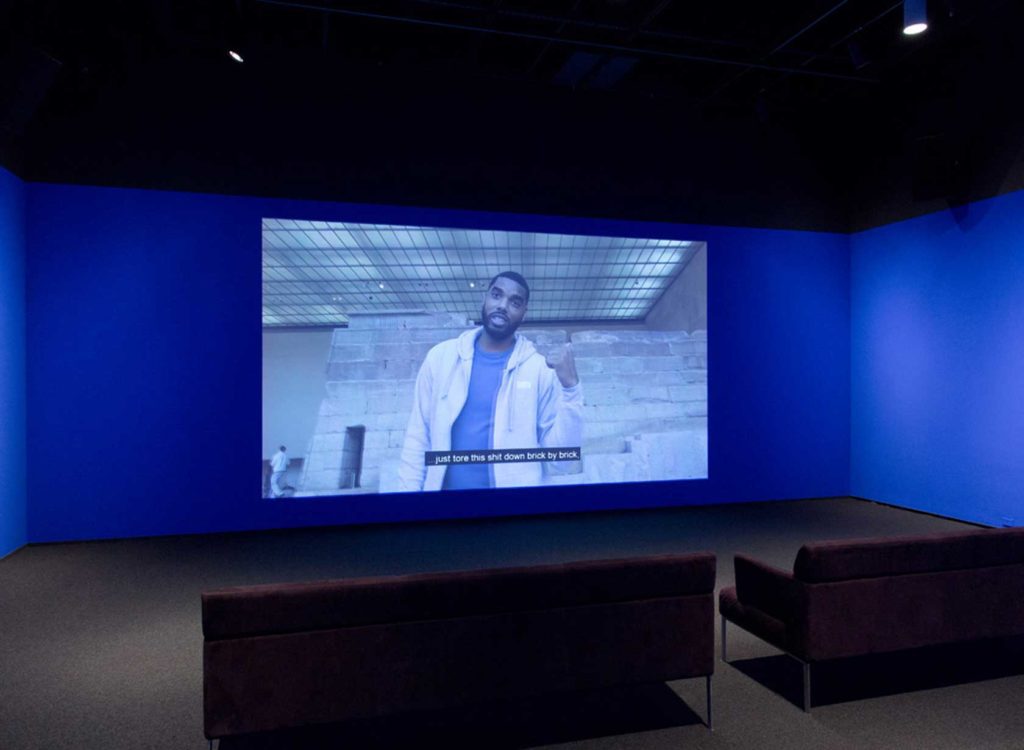What’s in a game?
Sondra Perry installation explores ownership and equity in institutions

The Davis Museum at Wellesley College reopened to the public on March 8 with a formidable artistic lineup, including Sondra Perry’s multimedia piece “IT’S IN THE GAME ’17 or Mirror Gag for Vitrine and Projection” and “Prison Nation,” a photography exhibit exploring mass incarceration.
“IT’S IN THE GAME ‘17 or Mirror Gag for Vitrine and Projection” was born from conversations Perry had with her twin brother Sandy Perry about his experience with race and class discrimination and exploitation in higher education. Sandy Perry’s likeness as a college basketball player was sold by the NCAA to Electronic Arts, a hugely popular video game production company, without his knowledge, consent or compensation.
There are a number of specific allusions happening here. “IT’S IN THE GAME” refers to the Electronic Arts slogan that sounds at the beginning of many of the company’s games. “Mirror Gag” refers to the sketch “Duck Soup” by the Marx Brothers wherein one brother mirrors the other, tricking him into thinking a broken mirror is still reflecting him.

Sondra Perry, IT’S IN THE GAME ‘17 or Mirror Gag for Vitrine and Projection (Installation), 2017, digital video projection in a room painted Rosco Chroma Key Blue, color, sound (looped). Commissioned by the Henie Onstad Kunstsenter, Oslo (HOK) and the Institute of Contemporary Art (ICA), University of Pennsylvania for the exhibition Myths of the Marble, 69 120 inches (screen),16:20 minutes, courtesy of the artist and Bridget Donahue, NYC. Still courtesy of Bridget Donahue and Electronic Arts Intermix (EAI), New York.
“When you’re watching this video, Perry is asking, ‘Where is the mirror, what is the mirror gag?’” says Amanda Gilvin, assistant director of curatorial affairs at the Davis Museum. By addressing her brother’s experience, Perry calls into question identity and ownership, especially the ownership of Black bodies throughout history. Here, her brother is mirrored in a video game, and as twins, she and her brother are also mirroring each other. At other points in the video, Sandy Perry looks at artwork in museums, mirroring portraits in cultural institutions.
Bringing museums into the equation causes audiences to reflect on ownership in those spaces as well. Perry shows open-sourced 3-D scans of works from the Metropolitan Museum of Art and the British Museum. These objects are not always acquired ethically in their physical form, but is the 3-D scan not also a mirroring of that artwork? What does it mean to replicate an artwork that doesn’t rightfully belong there in the first place?
The platform hosting these scans is the same one the Davis Museum uses to host their virtual exhibitions. “I think it’s vital to be self-critical,” says Gilvin, “and to invite multiple perspectives in order to better understand what it is we’re doing and the kinds of systems with broad historical reach in which we’re participating.”
With this exhibition, the Davis Museum is reflecting on itself as an institution, both in terms of art ownership and of educational equity as a museum associated with a university. “IT’S IN THE GAME” causes viewers to examine similar inequities that may occur where the piece is being shown. Perry’s video installation can be viewed onsite at the Davis Museum or online.
“This installation really asks all of us to be self-reflective and look back at ourselves and what kinds of systems of radicalized power we participate in, even in seemingly benign leisure activities,” says Gilvin. “I hope [audiences] look at their own experiences with higher education and with video games in a more expansive historical frame.”







